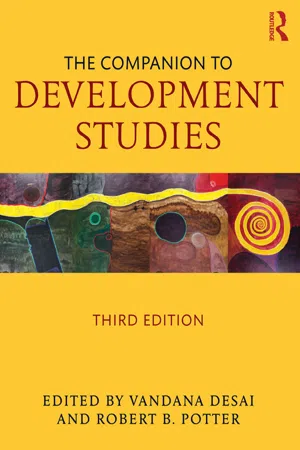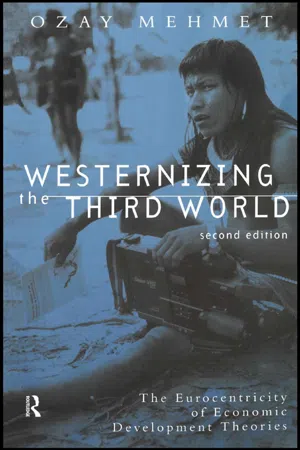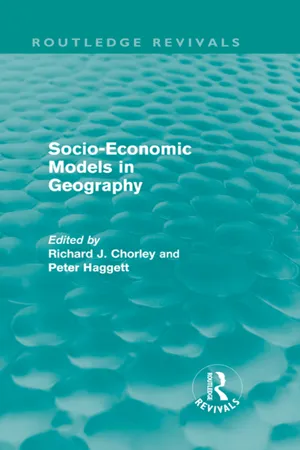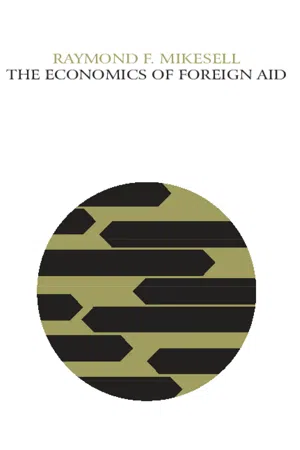Geography
Rostow Model
The Rostow Model, also known as the "Stages of Economic Growth," is a framework that outlines the development stages of a country. It suggests that all countries go through five stages of economic development, from traditional society to high mass consumption. The model is criticized for its linear approach and lack of consideration for social and political factors influencing development.
Written by Perlego with AI-assistance
Related key terms
Related key terms
1 of 4
Related key terms
1 of 3
5 Key excerpts on "Rostow Model"
- eBook - ePub
- Vandana Desai, Rob Potter, Vandana Desai, Vandana Desai, Rob Potter(Authors)
- 2014(Publication Date)
- Routledge(Publisher)
Walt Rostow’s ‘uni-linear’ model (1960; see Figure 2.4.1) is probably the best-known attempt to show how a country’s economy and society progress through a series of stages, and is firmly based on the Euro-American experience. It was undoubtedly the most influential modernization theory to emerge in the early 1960s. It is interesting to note that Rostow entitled his book The Stages of Economic Growth: A Non-communist Manifesto and, ‘[his] perception of the purpose of the United States’ promotion of economic development in the Third World was governed by a strongly anti-communist stance’ (Hunt, 1989: 96). Indeed, early in his book Rostow asserts that he is aiming to provide ‘an alternative to Karl Marx’s theory of modern history’ (Rostow, 1960: 2). The key element in Rostow’s thinking was the process of capital formation, represented by five stages through which all countries pass in the process of economic growth. • Stage 1, Traditional society : Characterized by primitive technology, hierarchical social structures, production and trade based on custom and barter, as in pre-seventeenth-century Britain. • Stage 2, Preconditions for take-off : With improved technology and transport, increased trade and investment, economically based elites and more centralized national states gradually emerged. Economic progress was assisted by education, entrepreneurship and institutions capable of mobilizing capital. Often traditional society persisted side by side with modern economic activities, as in seventeenth- and eighteenth-century Britain, when the so-called ‘agricultural revolution’ and world exploration (leading to increased trade) were gaining momentum. While the preconditions for take-off were actually endogenous in Britain, elsewhere they were probably the result of ‘external intrusion by more advanced societies’ (Rostow, 1960: 6). • Stage 3, Take-off : The most important stage, covering a few decades, when the last obstacles to economic growth are removed - eBook - ePub
The History of Development
From Western Origins to Global Faith
- Gilbert Rist, Patrick Camiller, Patrick Camiller(Authors)
- 2019(Publication Date)
- Zed Books(Publisher)
4 Hence the subtitle: ‘A Non-Communist Manifesto’. The book’s huge success was no doubt due to the fact that it convincingly addressed these two concerns, even if the conviction it sought to share often hinged upon a dubious line of argument. At a historical moment when the field of ‘development’ was taking shape, Rostow showed how it could be of interest not only for theoretical reflection but also for the race to keep ahead in economics and politics. But before we examine the reasons for its cult status, we should outline the content of the new doctrine.A PHILOSOPHY OF HISTORY: ROSTOW’S STAGES OF ECONOMIC GROWTHThe excellent summary that Rostow himself provides of his general thesis opens as follows: ‘It is possible to identify all societies, in their economic dimensions, as lying within one of five categories: the traditional society, the preconditions for take-off, the take-off, the drive to maturity, and the age of high mass-consumption.’5 This announces the extremely general level of the whole argument, with its small number of ‘laws’ applying to ‘all societies’.6 On the other hand, the use of such terms as ‘degree of development’, ‘stages’ or ‘maturity’ suggests the strong influence of an organicist metaphor of ‘development’, especially as Rostow himself talks of ‘the essentially biological field of economic growth’.7Alongside this, there is the aeronautical metaphor of ‘taking off’, rapidly incorporated into ‘development’ jargon, which partly accounted for the book’s success.8 By depicting the future of societies in the manner of an aeroplane that speeds to the end of a runway and climbs rapidly skyward above all earthbound obstacles, Rostow also seemed to be conjuring up the asymptotic graph of every company’s ideal performance. At least this is what is suggested by his constant references throughout the book to ‘the powerful arithmetic of compound interest’,9 seen as ‘a major independent variable in the stages-of-growth’.10 It is this almost-divine force, appearing as the engine of growth, which is supposed to ensure that ‘the age of high mass-consumption becomes universal’.11 - eBook - ePub
Westernizing the Third World
The Eurocentricity of Economic Development Theories
- Ozay Mehmet(Author)
- 2002(Publication Date)
- Routledge(Publisher)
A Non-Communist Manifesto, believed that the hearts and minds of the people of the Third World could be won over for American capitalism through a Marshall Plan type of foreign aid. His optimism was derived from his Eurocentric worldview which led him to the conclusion that ‘the lesson [of economic history, i.e. Western experience]…is that the tricks of growth are not that difficult’ (Rostow 1960:166). Rostow saw capitalist development as historically inevitable; European and American experiences were confirmations of a long-term uni-directional transformation that could be subdivided into:(Kuznets summary quoted in Meier 1989:69)(1) distinct time segments, characterized by different sources and patterns of economic changes, (2) a specific succession of these segments, so that b cannot occur before a, or c before b, and (3) a common matrix, in that the successive segments are stages in one broad process—usually one of development and growth rather than of devolution and shrinkage.Each one of these stages was interlinked through a dynamic theory of production where transition from one to the next was characterized by certain changes in the composition of investment. ‘Turning points’ and ‘leading sectors’ were the essential elements of the Rostowian stages theory.Rostow’s ‘distinct time segments’ along an inevitable path of unidirectional growth consisted of five stages: (1) the traditional society, (2) the preconditions for take-off, (3) the take-off, (4) the drive to maturity and (5) the age of mass consumption. The developing countries of the Third World were in the first three stages, whereas countries of the First World were in the last two.As an economic growth theory, the most important Rostowian stage was the ‘take-off.’ It was the launching pad of accelerated capitalist growth. It is here that Rostow saw the trigger or the magic wand of economic growth; or, more precisely, how its rate could be deliberately - Richard Chorley, Peter Haggett(Authors)
- 2013(Publication Date)
- Routledge(Publisher)
These criteria are very useful in assessing proposed conceptual/historical models. The earliest such were the ‘stage theories’ of certain late nineteenth-century German economists, such as List, Hildebrand, Bucher and Smoller. These models organized the economic history of the then advanced countries into stages distinguished from each other by a variety of criteria – by character of exchange system in Hildebrand’s model (barter; money; credit), by dominant occupations in List’s (savage; pastoral; agricultural; agricultural and manufacturing; agricultural, manufacturing and commercial) (Enke, 1964, pp. 191–194). However, these early stage models were in fact little more than descriptive classifications of different types of economic organization supposed to follow each other in time (Goldsmith, 1959, p. 25): and when tested against the real world, their extremely low level of applicability rendered them virtually useless as analytical tools (Hoselitz, 1960, pp. 193–238; Meier and Baldwin, 1957, pp. 143–147; Gras, 1930).The attempt to develop a more sophisticated and meaningful stage model of economic growth has only been made in quite recent years. Since its initial formulation (1955, Chap. 7 , and 1956), extension (1959) and final elaboration (1960), Rostow’s generalization of ‘the sweep of modern history’ as ‘a set of stages-of-growth’ (Rostow, 1960, p. 1) has attracted remarkable attention. Accepted with alacrity both by economists concerned with underdeveloped countries (Haq, 1963, p. 13; Das-Gupta, 1965, p. 56; Enke, 1964, p. 201; Meier, 1964, p. 3; Brandenburg, 1964, p. 96) and by the intelligent public (Ohlin, 1961, p. 648; Magee, 1965, p. 76), it has none the less provoked strong criticism from economists in developed countries. Its five stages are portrayed diagrammatically in Figure 8.2 . Rostow’s own chart applying the model to particular countries is reproduced in Figure 8.3 .8.2 The Rostow Model.8.3 The Rostow Model Applied to Selected Countries. (Source: Rostow, 1960, p. xii. The chart was originally published in The Economist, August 15, 1959, p. 413).The model’s base-level, as it were, is the traditional society, characterized by limited technology, pre-Newtonian attitudes to science and the physical world, and a static and hierarchical social structure. As primarily exogenous influences stimulate the beginnings of a rise in the rate of productive investment, the installation of ‘social overhead capital’ (roads, railways, etc.), and the evolution of a new social/political elite, the preconditions for take-off stage develops, with agriculture and extractive industry playing a key role. The crucial stage, however, is take-off, the ‘decade or two’ when economy and society ‘are transformed in such a way that a steady rate of growth can be, thereafter, regularly sustained’ (Rostow, 1960, pp. 8–9). In practical terms, take-off is launched by some initial stimulus, and characterized by ‘a rise in the rate of productive investment… to over 10 per cent of national income’, the ‘development of one or more substantial manufacturing sectors, with a high rate of growth’, and the emergence of ‘a political, social and institutional framework’ which encourages growth (Rostow, 1960, p. 39). After take-off follows the drive to maturity, during which the impact of growth is transmitted to all parts of the economy. Finally, with the shift in sectoral leadership to industries such as durable consumer goods, ensues the age of high mass-consumption – although other alternatives, such as the pursuit of international power, or of the welfare state, may be chosen by particular societies instead.- eBook - ePub
- Raymond F. Mikesell(Author)
- 2017(Publication Date)
- Routledge(Publisher)
For countries which had not reached the stage at which the fundamental conditions for growth were assured, the major problem was to show how countries moved from one stage to another. In the nineteenth century, Karl Marx and various economists of the German Historical School designated and described various stages in the economic and social evolution of society. The best known protagonist of the historical stage approach today is Walt W. Rostow, whose historical stage theory has not only an enormous influence on modern development economists, but who as much as any other economist has influenced public policy, especially as related to foreign aid. 2 Virtually all economists are familiar with Rostow’s (1960) five stages: (1) the traditional society; (2) the long period during which the economic and social preconditions for growth are evolved; (3) the relatively short period of the “take-off"; (4) the rapid drive to maturity; and (5) the era of high mass consumption, or alternatively, high social investment in military and space machinery for the achievement of a position of a world power (or both, as in the case of the United States, if the country can afford it). The most important and most controversial aspect of Rostow’s theory relates to the take-off stage. The concept of “the take-off into self-sustaining growth” has become a part of the standard lexicon of foreign-aid policy makers and is generally employed in the literature of development economics, even by those who have serious doubts regarding the validity of the entire concept
Index pages curate the most relevant extracts from our library of academic textbooks. They’ve been created using an in-house natural language model (NLM), each adding context and meaning to key research topics.
Explore more topic indexes
Explore more topic indexes
1 of 6
Explore more topic indexes
1 of 4




